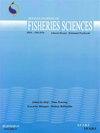里海南部水域基尔卡渔业的社会经济分析(伊朗水域)
IF 0.6
4区 农林科学
Q3 FISHERIES
引用次数: 0
摘要
使用调查表收集了里海南部基尔卡渔业的社会经济数据,调查表由与渔业活动相关的不同变量组成,以评估其社会经济表现。收集的数据包括就业和评估、社会和经济指标、成本结构、生计、就业和盈利能力、投资水平、债务、补贴、活动水平、人口统计和所有权结构。分析结果表明,在马赞德兰省,80%的船主积极参与船只捕捞活动。吉兰省12-18段LOA的这一数字为90%,18-24段LOA为40%。调查还显示,船主在捕鱼作业期间出现在船上的船只收入较低,成本较高。根据分析,这两个省的所有航段共有377.4名船员。每艘渔船的平均船员人数为5.1人。据计算,这两个省从事基尔卡渔业的不同个体数量为480人。据计算,基尔卡船队在里海南部的每个船员的平均工作时间为每年1212.1小时。不同血管段(12-18 LOA Mazandaran、12-18 Gilan和18-24 LOA)的这一指数分别为1230.8、1182.7和1221.0。比较马赞德兰和吉兰的相同船只段的这一指数,发现马赞德兰船队段高出48小时。马赞德兰舰队的活动水平(海上天数)估计为5485.8天,高于吉兰舰队。总的来说,63%的工作量(海上天数)属于马赞德兰舰队。整个基尔卡渔场的每日捕鱼时间计算为每天16.5小时。研究年度(2017年),整个船队的年总捕鱼时间为144108小时,其中90351小时属于马赞德兰船队(12-18 LOA),捕鱼时间较高(63%)。根据结果,基尔卡渔业50%以上的运营成本属于船员份额(工资),运营成本的最低部分属于能源成本。结果显示,2017年,整个基尔卡船队在里海共消耗了260万升燃料和石油,其中75%属于马赞德兰船队。2017年每美元=3885托马斯(伊朗货币)。本文章由计算机程序翻译,如有差异,请以英文原文为准。
Socio-economic analysis of Kilka Fisheries in Southern waters of the Caspian Sea (Iranian waters))
Socio-economic data of Kilka fisheries in the south part of the Caspian Sea were collected using questionnaire form which consists of different variables related to the fishing activity to evaluate its socio-economic performance. The data collected were employed and assessed, social and economic indicators, cost structure, livelihoods, employment and profitability, level of investments, debts, subsidies, activity levels, demographics and ownership structures. The result of the analysis shows that in Mazandaran province 80% of the vessels owners were active in vessels fishing operation. This figure was 90% for the segment 12-18 LOA and 40% for the segment 18-24 LOA of Gilan province. The survey also showed lower revenue and higher costs for the vessels that owner present on the board of vessel during fishing operation. According to the analysis a total of 377.4 crew were engaged on the board of all the vessel segments in both provinces. Mean number of crew engaged on the board of each fishing vessel was 5.1. The numbers of different individuals engaged on Kilka fisheries in both provinces were calculated to be 480. The average working hours per crew for the Kilka fleets in the southern Caspian Sea calculated to be 1212.1 hours per year. This index for different vessel segments, 12-18 LOA Mazandaran, 12-18 Gilan and 18-24 LOA, were 1230.8, 1182.7 and 1221.0 per individual respectively. Comparing this index for the same vessel segments in Mazandaran and Gilan, showed 48 hours higher for Mazandarn fleet segment. The activity level (days at sea) for Mazandaran fleet was estimated to be 5485.8 days, which higher than Gilan fleets. In general, 63% of the effort (days at sea) was belonged to Mazandaran fleet. Daily duration of fishing trip for whole Kilka fisheries was calculated as 16.5 hours per day. Total yearly duration of fishing trip for whole fleets for the year under study (2017) was 144108 hours, from which 90351 hours were belonged to Mazandaran fleet (12-18 LOA) with higher fishing trip (63%). According to results more than 50% of the operational costs of Kilka fisheries were belonged to crew share (salary) and the lowest portion of the operational costs were belonged to energy costs. The results show that total of 2.6 Million liters of fuel and oil were consumed by whole Kilka fleet in the Caspian Sea in 2017, which 75% of this amount was belong to Mazandaran fleet segments. Each $US in 2017= 3885 Tomans (Iranian Currency).
求助全文
通过发布文献求助,成功后即可免费获取论文全文。
去求助
来源期刊

Iranian Journal of Fisheries Sciences
FISHERIES-
CiteScore
2.30
自引率
11.10%
发文量
0
审稿时长
3 months
期刊介绍:
1- Living various species (contains animals and vegetal species) in various aquatic ecosystems.
2- Health and diseases of aquatic species.
3- Determining the stocks and specific time and location for catching and reliable exploitation for sustainable development.
4- Methods of propagation and culture of high value aquatic resources.
5- Aquatic stock assessment and the methods of restocking the high value species and suggestion for rate, areas and the time for releasing fish and other aquatic organisms fries.
6- Pollutant agents and their effects to the environments of aquatic species.
7- Feed and feeding in aquatic organisms.
8- Fish processing and producing new products.
9- The economic and social aspects of fisheries.
 求助内容:
求助内容: 应助结果提醒方式:
应助结果提醒方式:


